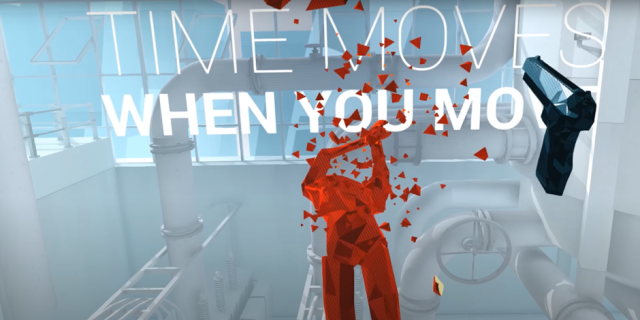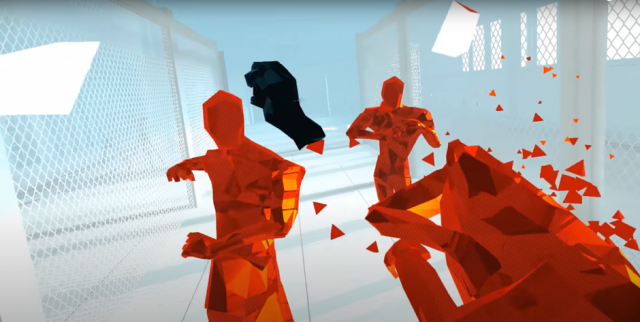Slowing down, and the world slows down with you. This is one of the most intriguing designs that I have seen in VR games, and you can experience it in Superhot VR.

Superhot VR is a first-person action game of solving puzzles via dodging bullets and killing enemies developed and published by Superhot Team. It invites the player to experience both motion and time at a more precise level than what people could do in real life. In the game, time only progress when the player moves. Just like the movie Matrix, you can catch each bullet path and take your time to decide how to keep your body intact while killing the opponents as the world freezes around you. That is nothing you can experience in real life.
Another reason why I am particularly fond about the game is its aesthetics. A lot of VR games strive to mimic the real-world environment for immersive gameplay. But Superhot is set in a rather surreal place. Everything in the environment is painted dull white from walls to tables. The enemies seem to be made of crystal red glass that shatter in crisp sounds when you break them. They are like statues devoid of human flesh, facial expression, and blood. I like this reductionist approach towards reconstructing our reality where things are no more than what they need to be. By removing the colour and texture of mundane items, it draws our attention to their form, shape, arrangement, and relationship as we watch the glassy figures jumps out of those constructs. There is definitely a psychological and artistic impact to this game.

Yet, the game feels real because of the flexibility given to players to interact with the tools they have. A gun can be used to shoot but also thrown at enemies when out of bullets. A knife can cut the bullets away in the air. Games often restricts the amount of freedom players have in order to prevent them from going off track, which could be intrusive to the immersion. Having less objects to play around but more freedom to decide what to do with them is a smart way to make the “reality” authentic and engaging.
There are also merits to the interaction design in the game. To proceed to the next section, the player is to hit, grab, or shoot some object with real actions as if one is still interacting with the virtual world. The instructional text is kept minimal and attached to the surrounding environment, making the game experience holistic and immersive. While the game requires a lot of body movement, no repositioning through the virtual environment is needed, avoiding motion sickness.
It is a pity that there is not much variation to the virtual environment since I really love the aesthetics and design techniques of the game and would love to see the game setting in dark or in the wild. In terms of interaction, one small issue is that although it is impossible for players to move around with their feet, the virtual space sometimes surrounds the player with edges that seems like one could fall off. I feel like a small indication of boundary could help the player to move more freely without having to worry about the edges.
